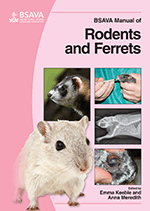
Full text loading...

Ferrets exhibit signs of pain in a different way to dogs and cats and for this reason it is frequently reported in the literature that they are stoical and not very sensitive to pain. Practitioners experienced with ferrets find just the opposite: ferrets are extremely sensitive to pain and stress, with the consequence often being haemorrhage and ulceration of the gastrointestinal (GI) tract. Pain also contributes to anorexia and dehydration that may exacerbate endocrine disorders such as islet cell neoplasia (insulin-producing), renal disease and cardiomyopathy. This chapter examines Analgesia; Local and epidural analgesia and anaesthesia; Sedation and anaesthesia; and Postoperative procedures.
Ferrets: anaesthesia and analgesia, Page 1 of 1
< Previous page | Next page > /docserver/preview/fulltext/10.22233/9781905319565/9781905319565.22-1.gif

Full text loading...


 = the approximate exit of the infraorbital nerve through the infraorbital foramen on the lateral aspect of the face. The zygomatic nerve also exits this foramen.
= the approximate exit of the infraorbital nerve through the infraorbital foramen on the lateral aspect of the face. The zygomatic nerve also exits this foramen.
 = the mandibular nerve blocking area. It lies on the medial aspect of the mandible and is approached from inside the oral cavity.
= the mandibular nerve blocking area. It lies on the medial aspect of the mandible and is approached from inside the oral cavity.
 = the approximate location on the lateral surface of the mandible of the exit of the mental nerve from the mental foramen.
= the approximate location on the lateral surface of the mandible of the exit of the mental nerve from the mental foramen.
 = represents the approximate area for the maxillary nerve block. See text for further details. © 2009 British Small Animal Veterinary Association
= represents the approximate area for the maxillary nerve block. See text for further details. © 2009 British Small Animal Veterinary Association
 = the approximate exit of the infraorbital nerve through the infraorbital foramen on the lateral aspect of the face. The zygomatic nerve also exits this foramen.
= the approximate exit of the infraorbital nerve through the infraorbital foramen on the lateral aspect of the face. The zygomatic nerve also exits this foramen.
 = the mandibular nerve blocking area. It lies on the medial aspect of the mandible and is approached from inside the oral cavity.
= the mandibular nerve blocking area. It lies on the medial aspect of the mandible and is approached from inside the oral cavity.
 = the approximate location on the lateral surface of the mandible of the exit of the mental nerve from the mental foramen.
= the approximate location on the lateral surface of the mandible of the exit of the mental nerve from the mental foramen.
 = represents the approximate area for the maxillary nerve block. See text for further details.
= represents the approximate area for the maxillary nerve block. See text for further details.



